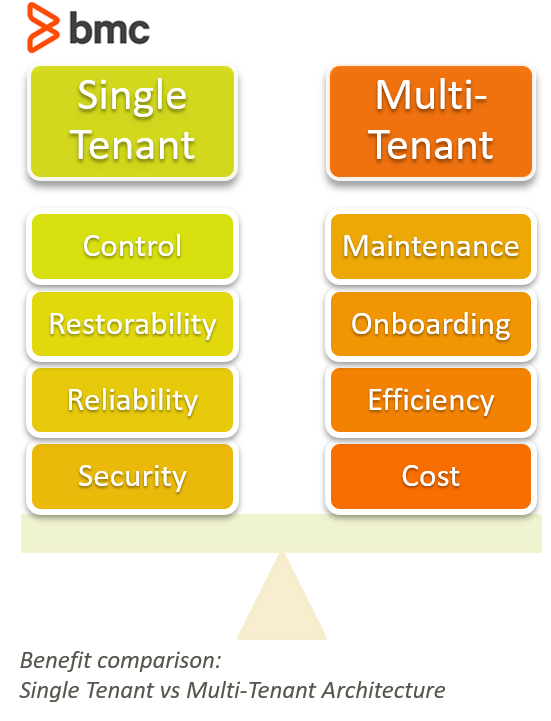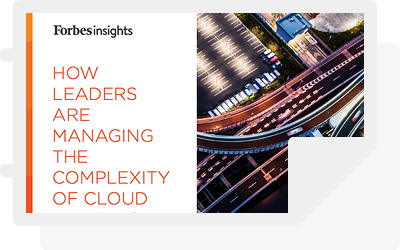One of the single most important parts of an enterprise digital transformation strategy involves finding the right SaaS service or services that complement your business model, culture, and compliance needs.
When you begin learning about the different SaaS products available to your organization, you’ll discover two different types of architecture:
- Single tenant architecture
- Multi-tenant architecture
Let’s take a look at both.
Single vs multi tenant architecture
In a single tenant SaaS environment, the tenant is the SaaS client. By design, this type of architecture allows for a single instance of a piece of software per client to run on the SaaS server.
Think of the server environment as a business ecosystem. The best way to describe the nature of single tenant architecture is to imagine each client as its own office building and the server as the street that all of the SaaS clients operate from. Each runs its encapsulated operations within their individual office, and offices are lined up side-by-side on the street.
In a multi-tenant environment, the clients are still offices, but this time, they are all located within one high-rise building. Each client operates from its own space within a larger SaaS software product.
This real estate example of single tenant and multi-tenant rings true to its name. In technology, single tenant and multi-tenant platforms offer different benefits and drawbacks. Which is right for your business? Keep reading to learn more.

Single tenant SaaS architecture: Benefits
First, let’s take a look at the advantages that single tenancy has to offer:
- Security. While no system is 100% secure, single tenant environments more readily allow for increased security as each customer’s data is completely separate from any other’s. The chance that one customer will accidently access another’s data (as in a multi-tenant environment) is essentially eliminated.
- Reliability. Single tenant architectures are widely considered to be more reliable because the performance of one customer’s software instance is not affected by the performance of another customer’s.
- Easily restored. In a single tenant environment, you have more control over backups and recovery as one system is backed up to one dedicated part of a SaaS server. On the other hand, in a multi-tenancy environment, this process is much more convoluted to the point that it’s not always available to users.
- Ease of migration. For enterprises that may eventually want to move into a self-hosted environment, the process is less complicated with a single tenancy.
- Full control. In a single tenancy, you have full control over the environment. That means the platform offers much more flexibility in terms of customization. Your added control also applies to upgrades and updates.
Multi-tenant SaaS architecture: Benefits
Some advantages of multi-tenant environments are ideal for certain organizations:
- Lower cost. One financial benefit of a multi-tenant operation is that the per user cost is lower because all resources are shared. If you’re searching for a solution that makes the most financial sense, a multi-tenancy might be it.
- Efficient resource usage. Because all the resources are shared, multi-tenancies operate at maximum resource usage, which makes for optimum efficiency. The system is a constantly moving environment where resources are being simultaneously accessed.
- Ease of set up and onboarding. SaaS platforms offering multi-tenant environments are usually sticklers for providing top-notch customer service. That’s because they have a high volume of customers and need to ensure each has a good experience. The multi-tenant environment is largely the same for each customer, with some optional configurations, making it easier for multi-tenant SaaS companies to perfect the onboarding process and optimize it for ease of use.
- Maintenance. Updates applied to the system affect all customers and, as such, system upgrades and update maintenance are usually handled by the SaaS company, not the individual customer. Because of this, multi-tenancies usually require less maintenance.
Difference between Multi-Tenancy and Multi-Enterprise
It’s worth noting the distinction between multi-tenancy and multi-enterprise. They are two very different concepts, yet easy to confuse.
- Multi-enterprise, also known as multiple-enterprise business networks, are B2B ecosystems that enable two or more parties to collaborate on an activity. According to Gartner, these processes aren’t commonly seen as they focus on “complex relationships or business processes” but they always underscore a “shared objective, shared risk, shared reward and/or shared investment.”
- A multi-tenant environment refers to a vendor related term describing how a software solution is managed.
Single and multi-tenancy environments: Drawbacks
For all the good things about single and multi-tenant SaaS services, there are drawbacks as well.
Limitations of single tenancy
Single tenancy is a secure and reliable choice for enterprise businesses but despite the many, you should also consider the following:
- Single tenancy is usually more costly. It isn’t as easy to implement as a multi-tenant environment. It requires more time and resources when it comes to customizations and maintenance. In addition to a more costly program, there are other costs of ownership to consider that may make this option less appealing.
- Requires more maintenance. Single tenant environments usually require updates and upgrades that must be managed by the customer.
- Resource utilization isn’t always maximized. In these environments the usage of resources isn’t always maximized, which may make for less efficient use.
Customers operating a SaaS program in a single tenant environment usually do so to safeguard financial applications and data, or other privileged information, making it less vulnerable to hacker attacks. But is this approach viable? As more and more businesses switch from a private to public cloud ecosystem, it remains to be seen.
Limitations of multi-tenancy
Multi-tenancy is a good choice for businesses that want to get started with fewer hardware requirements and easier onboarding. It is also ideal for customers who don’t have the internal resources needed to handle the maintenance requirements of single tenant SaaS environments.
While many applications are moving to multi-tenancy clouds like Salesforce, there are still some limitations:
- More vulnerable from a security standpoint. A multi-tenant environment leaves multiple access points which could be vulnerabilities if a cyber attack occurs.
- Backup and restoration. Some multi-tenancies are working to master the complicated waters of multi-tenant backups, but others don’t offer robust restoration options.
- Less control over the environment. Multi-tenancies offer fewer customizations, and users have less control over the quality of the environment.
- If something happens to one tenant all are affected. This can cause issues when it comes to uptime, preparing for system upgrades, and more.
Multi-tenancy is popular but its not without its limitations. Before deciding whether single tenancy or multi-tenancy is the right choice for your enterprise cloud needs, there are important considerations that need to be made.
How to choose tenancy
Multi-tenant architectures are the industry standard for enterprise SaaS applications, but that doesn’t mean developers should eschew the idea of operating a single tenant environment instead. Each has their best use case.
When deciding which is right for you, it’s important to consider what you want to accomplish.
Thinking about which is going to provide a development environment most similar to your current one, in some cases, may make a case for single tenant usage. For instance, if you want to have total control over the environment and maintenance, you may want to invest in a single tenant ecosystem. But single tenant infrastructures may be too cumbersome and bulky for companies looking for the most seamless digital transformation.
As for SaaS startups, there’s hardly one out there today operating in a single tenancy. The benefits of multi-tenancy for startups is too great.
But for businesses hoping to transition from a managed server environment into a self-hosted one, single tenancy is ideal.
Final Thoughts
At the beginning of this article we set out to define single tenancy and multi-tenancy, and help you decide which is best for your enterprise needs.
Single tenancy offers high user engagement with environmental customizations and control, reliability, more security, and a better propensity for backup and restore. One might think that makes single tenancy the obvious winner.
But with a much higher per person cost than its multi-tenant counterparts, single tenancy hardly competes in the SaaS marketplace today. After all, many multi-tenant options exist that promise data security, compliance, and offer great customer service and fast onboarding.
For most businesses, multi-tenancy is a comfortable option. But for discerning business leaders who need to make the best decisions to create a lasting competitive advantage in their industries, BMC offers multi-cloud management support.
With BMC’s Multi-Cloud Management solutions we help you remain efficient while you make the smoothest transition into the cloud.
BMC Multi-Cloud Solutions are uniquely positioned to help IT achieve the full benefits of multi-cloud ecosystems with industry-leading, vendor agnostic solutions for these required capabilities by:
- Customizing cloud services to meet business needs,
- Managing a variety of platforms from a single console,
- Enabling high-precision analysis across different applications, and
- Uniting cloud and enterprise management tools and processes.
Additional Resources
How Will Your Cloud Strategy Impact Your Cyber Strategy? from BMC Software







